Brightening up our mini-grassland this autumn are the seeded plumes of the Golden Bristle Grass. Not only do they catch our eye, but they also catch the attention of seed-eating birds.
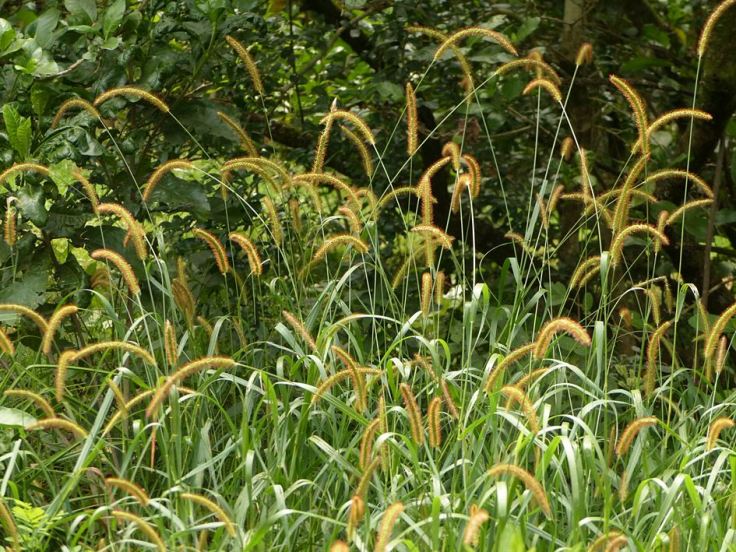
Also known as Golden Millet and South African Pigeon Grass, amongst other names, there are several varieties of Setaria sphacelata that are indigenous to Africa. The name Setaria derives from the Latin word for bristle
Naturally, the Golden Bristle Grass occurs in damp soils in grassland and woodland and even swampy areas, and in South Africa in the south eastern regions. In many African countries it is used as a pasture grass and it is also cut and used as hay. Once it has been established it can be heavily grazed. It has proved to be such a useful fodder crop that it has been introduced as such in other countries too, for example, in the Philippines and Australia. It is a nutritious plant, but as it is high in oxalic acid, especially when it is young, it is not suitable for feeding horses or lactating cows.
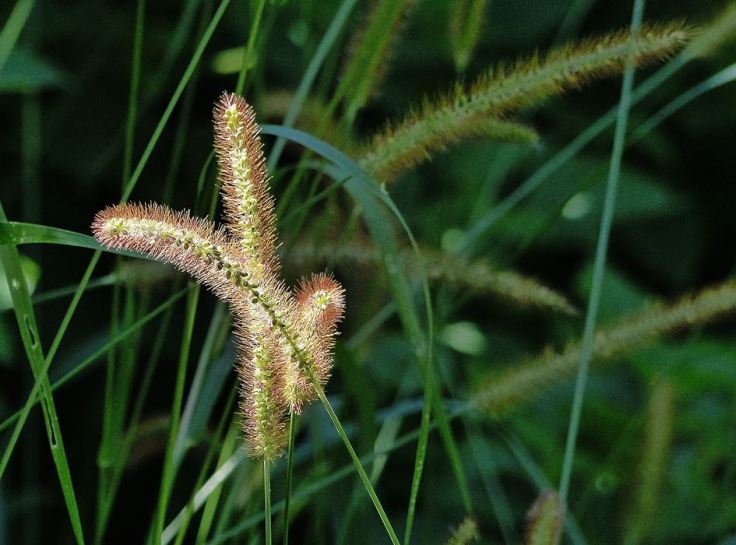
In this picture the seeds can clearly be seen. Unlike some similar grasses, the bristles remain on the stem even as the seeds mature and fall to the ground
The mini-grassland in our garden was established with a variety of grasses by the people who lived here prior to us. Over the years the composition of grasses and grassland plants has changed, and this year the Golden Bristle Grass has become dominant for the first time.

It has proved to be a good companion to this golden-coloured Kniphofia plant that comes up every year and flowers in late summer
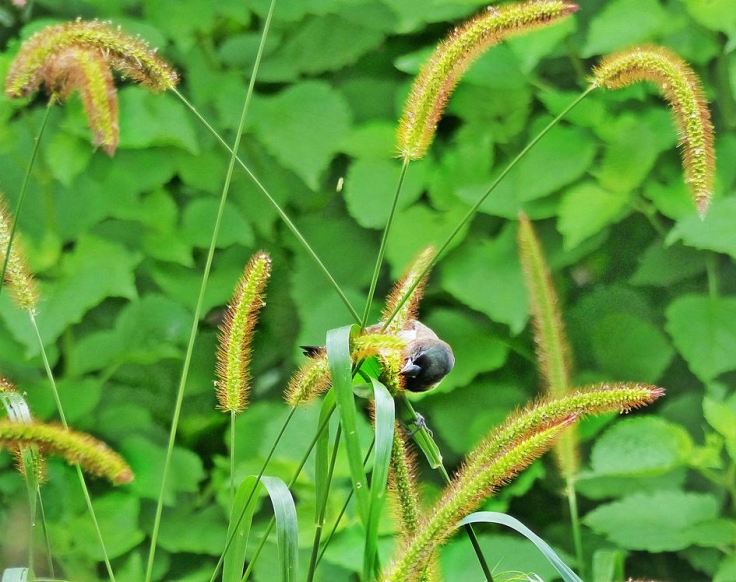
The seeds are particularly favoured by the Bronze Mannikins who visit the grassland to help themselves to seeds
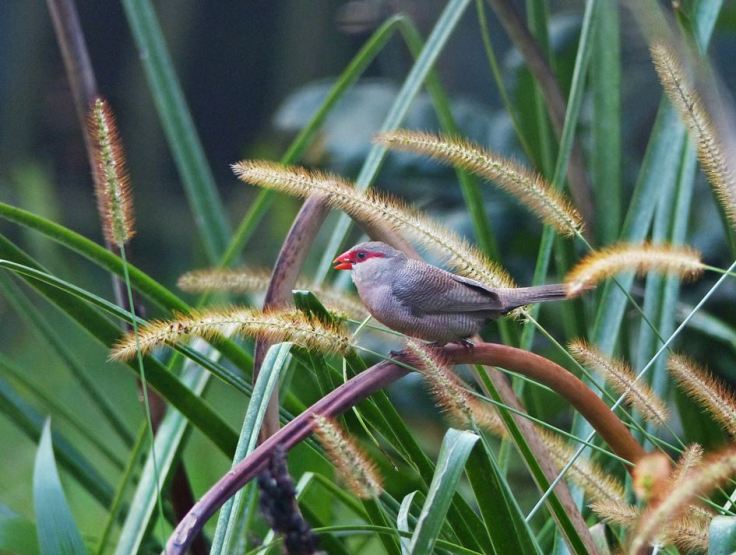
The Golden Bristle Grass seeds also attract the colourful Common Waxbill, which is a far from common but very welcome visitor in our garden
I hope that anyone with the space for wild grasses in their gardens will be encouraged to experiment and try planting some grasses. You will need only a small patch or even a pot, which get a bit of sun. Not only are wild grasses decorative, but they provide a more attractive and natural source of food for seed-eating birds than bird feeders do.
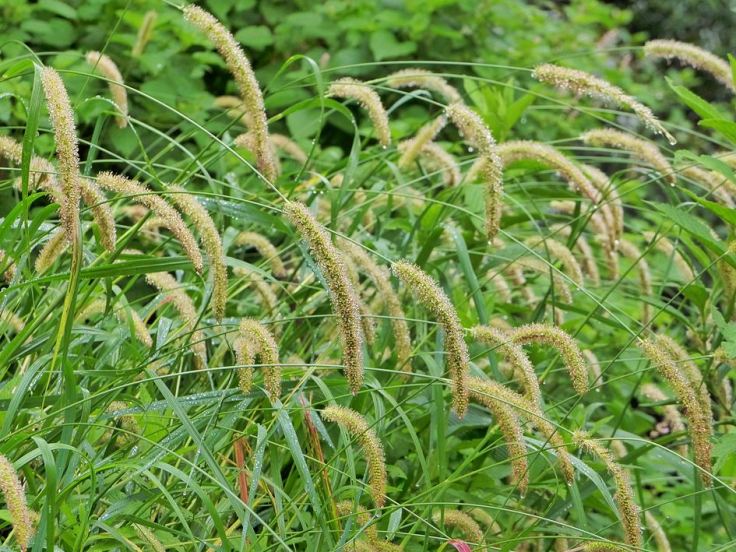
Decorated with shiny droplets of rain, the Golden Bristle Grass seed heads bow down under the weight of the water
This year in our garden grassland, once the seed has gone and the seed heads dry off, we will cut back the grasses and use the stems and dry leaves to top-dress the vegetable patch. This year we are experimenting with aspects of the no-dig method of gardening, and the dry straw and leaves from these grasses will be good to add to the other garden clippings that we layer on top of the beds in a kind of top-down sheet method of composting.
Sources:
FAO Grassland Species http://www.fao.org/ag/agp/agpc/doc/gbase/data/pf000316.htm; PlantZAfrica.com https://www.plantzafrica.com/plantqrs/setariamegaphyl.htm
Posted by Carol









June 4, 2017 at 3:29 pm
Your blog is just beautiful! I can’t wait to continue reading! Nature is just magical and you capture her with such grace!
LikeLiked by 1 person
June 4, 2017 at 6:04 pm
What a lovely thing to say. Thank you!
LikeLiked by 1 person
April 21, 2017 at 1:02 pm
I love your opening photo! I too am a big fan of native grasses here in Australia…and the no-dig gardening method which I teach to beginner vegetable growers at our Cancer retreats at work. It is a guaranteed way to create a microbial rich soil, the foundation of a healthy garden and healthy vegetables. Love your blog.
LikeLiked by 1 person
April 21, 2017 at 1:20 pm
Thank you so much. Glad to hear that you also appreciate native grasses. There is so much to enjoy that is often overlooked. Oftentimes we just need to adjust our perspective! It is great that the no-dig method seems to be catching on – good for the soil and for gardeners’ backs 🙂
LikeLiked by 1 person
April 21, 2017 at 8:16 am
What a captivating post, Carol. The photos are wonderful. You have also challenged a prejudice I didn’t know I had. When we plant grasses in the UK they are usually exotics. It has never occurred to me to nurture native grasses. We think of them as weeds. But then we don’t see many of our own wonderful indigenous varieties because most of landscapes have been treated to herbicides, and so we get fixated on getting rid of couch grass etc and don’t think of other species. I must look into this. Thank you. And good work on the on the no dig system. I’m finding it a challenge at the allotment simply because it’s hard to find enough material to cover the soil. It’s definitely easier to get to grips with in raised beds I find.
LikeLike
April 21, 2017 at 8:34 am
Thanks for the lovely comment Tish. I love it when I am alerted to my taken-for-granted assumptions when they are challenged by less conventional ideas, such as the no-dig method for example. I agree that it is hard to find enough layering material, so we are starting to use more cardboard that otherwise would have gone for recycling, as well looking for other ideas too. However, we don’t have to schlep everything to an allotment as you do! I admire your hard work and determination. I will interested to know if you discover any wild grasses suitable for your garden, or if you find that there is a movement in this direction in gardening practices in the UK. In SA there is a slowly increasing (though still minority judging from what is sold at nurseries) interest in indigenous and “water-wise” gardening. Even landscape designers at shopping malls and airports, for example, are increasingly using indigenous plantings.
LikeLike
April 21, 2017 at 5:12 am
I too encourage indigenous grasses to grow in parts of our garden and enjoy watching the birds that feed on them. Your Bronze Manikin and Commn Waxbill photographs are special. I am glad to hear you are also going for the no-dig method of gardening. I began that in my vegetable patch last year and intend to be more earnest about it – a real bonus has been a flush of cherry tomatoes that have grown in between everything and which now yield a small bowlful every week 🙂
LikeLike
April 21, 2017 at 6:01 am
Thanks Anne. We seem to have lot of gardening practices in common. Good to know that you are finding that the no-dig method is working out productively.
LikeLike